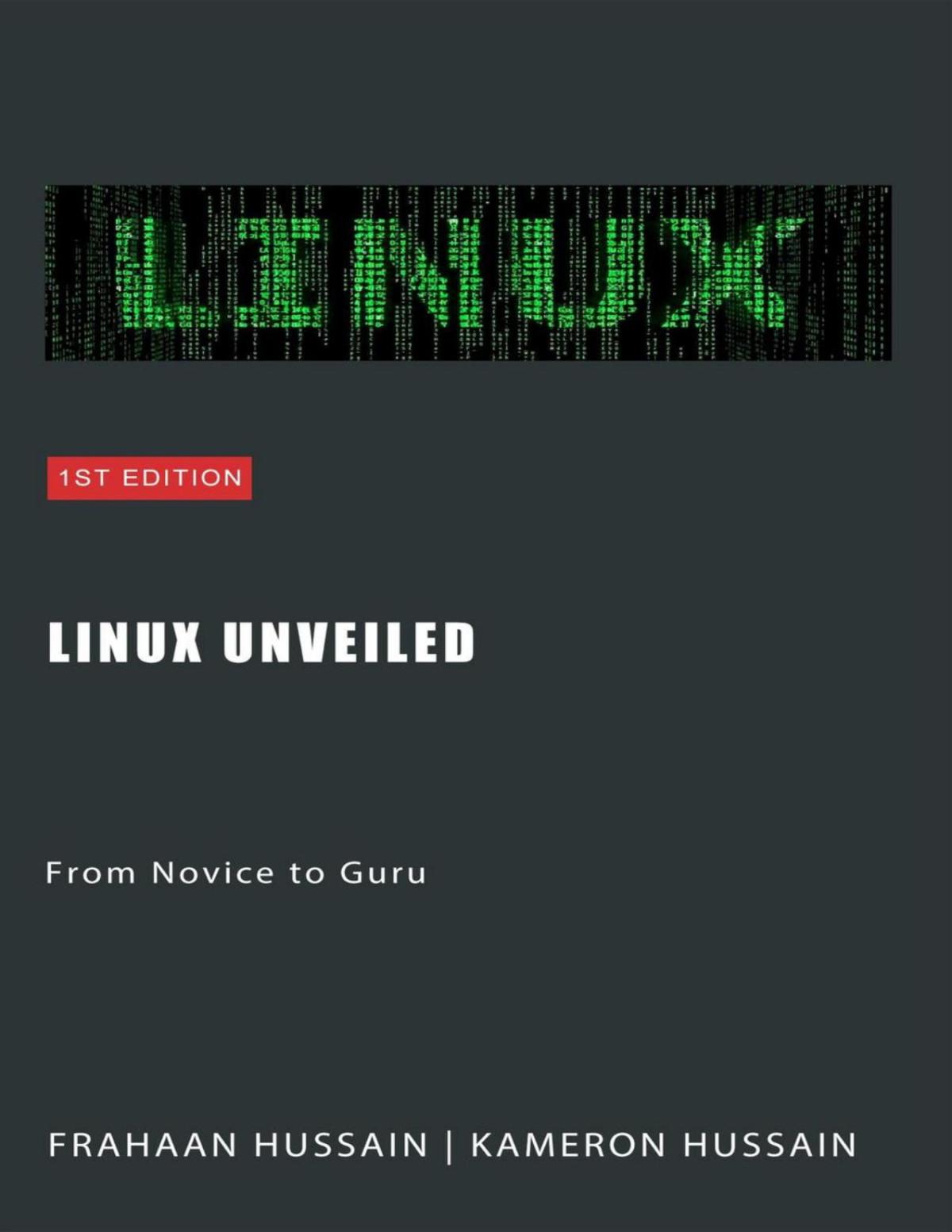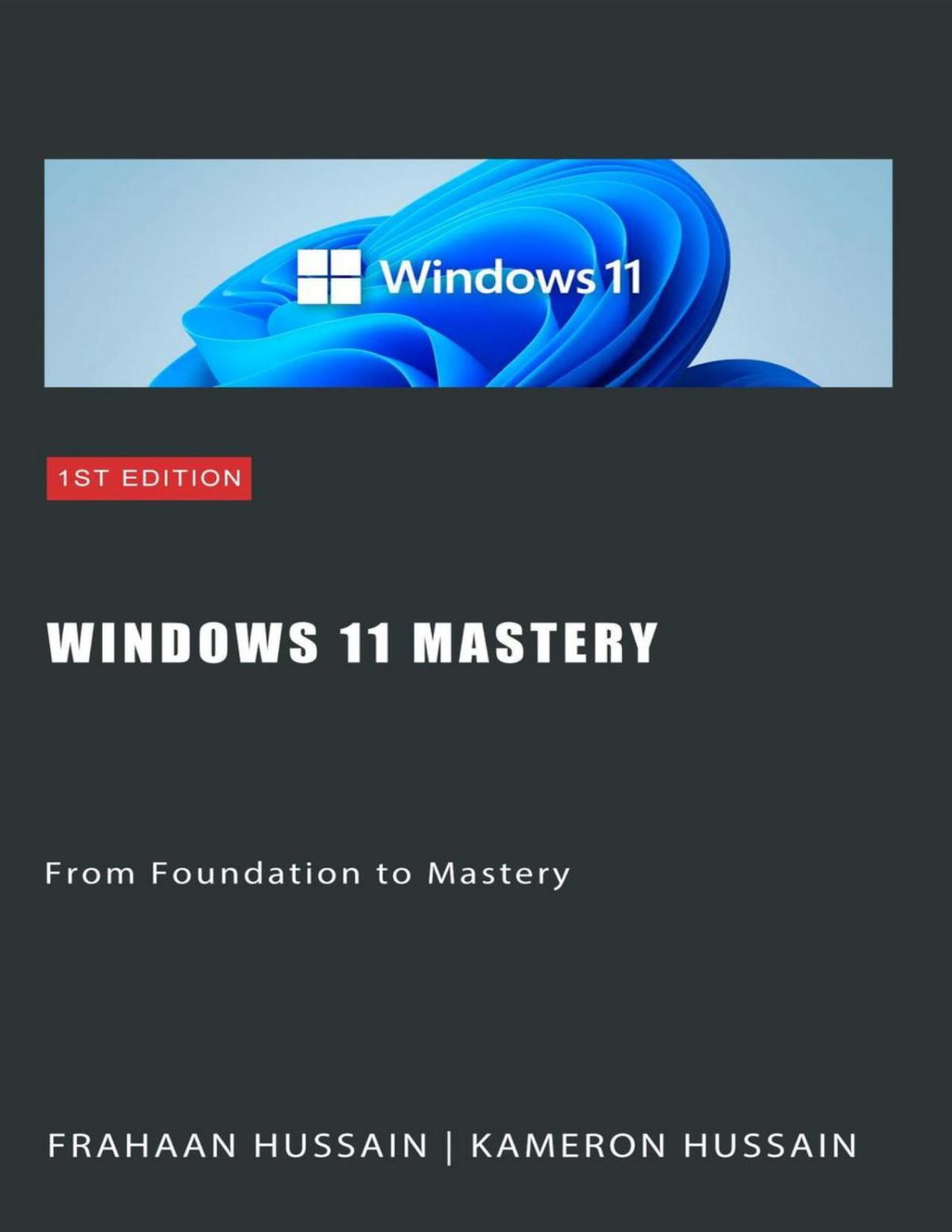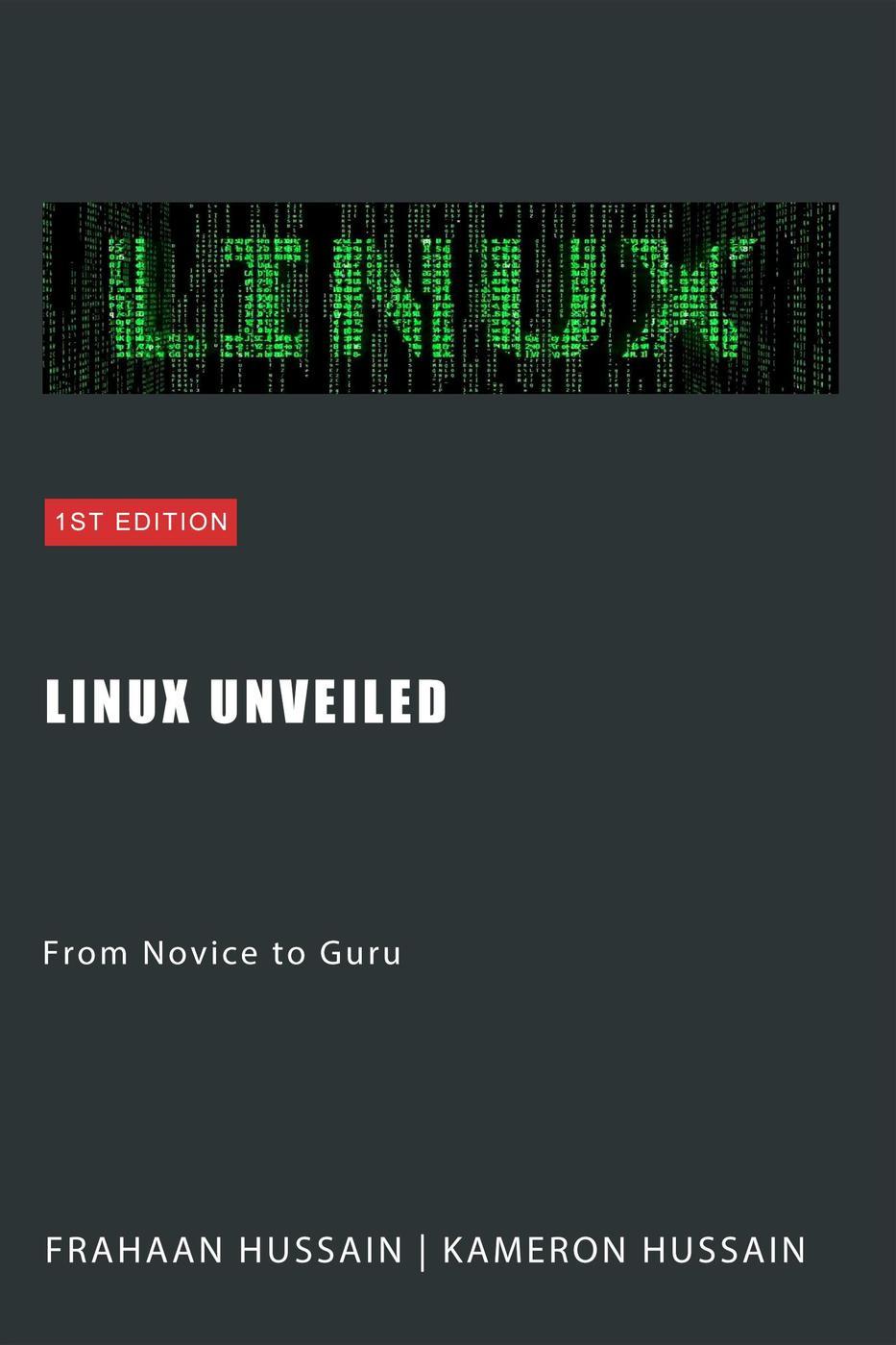TABLE OF CONTENTS
Linux Unveiled: From Novice to Guru
Table of Contents
Chapter 1: The Genesis of Linux
1.1. The Birth of a Penguin: Origins of Linux
1.2. Open Source Revolution: The Philosophy of Linux
Open Source Principles
The GNU GPL and Linux
Collaboration and Community
Advantages of Open Source
The Legacy of Open Source in Linux
1.3. Distributions Galore: Understanding Different Flavors
Diversity of Linux Distributions
Popular Linux Distributions
Specialized Distributions
Package Management Systems
1.4. Community and Culture: The Heart of Linux
The Open Source Community
Linux User Groups (LUGs)
Distribution Communities
Licensing and Freedom
The Linux Culture
The Global Impact
1.5. Linux vs. Other Operating Systems: A Comparative Study
Open Source vs. Closed Source
Licensing
Hardware Compatibility
Software Ecosystem
Command Line Interface (CLI)
System Updates and Security
Cost Considerations
User Community and Support
Use Cases
Conclusion
Chapter 2: Setting the Stage
2.1. Choosing the Right Distribution
Distributions and Their Varieties
Consider Your Use Case
Community and Documentation
Conclusion
2.2. Installation Essentials: A Step-by-Step Guide
Backup Your Data
Create Installation Media
Boot from Installation Media
Begin the Installation
Installation Progress
Complete the Installation
First Boot and Post-Installation Tasks
2.3. Navigating the Linux Desktop Environment
Common Desktop Environments
Desktop Elements
Keyboard Shortcuts
Customization
Conclusion
2.4. Basic Terminal Commands: The First Steps
Opening a Terminal
Understanding the Terminal Prompt
Basic Terminal Commands
Automation and Scripting
System Administration
Remote Access
Flexibility and Customization
Troubleshooting and Diagnostics
Learning the Command Line
Conclusion
3.2. Essential Command Line Operations
Command Syntax
Navigating the File System
File and Directory Manipulation
Viewing and Editing Files
Working with Permissions
Process Management
3.3. File Management and Navigation
Listing Files and Directories
Navigating Directories
Creating and Removing Files and Directories
Copying and Moving Files
Finding Files
Conclusion
3.4. Users and Permissions: A Security Primer
User Accounts
User Management Commands
User Permissions
Changing Permissions
Ownership and Groups
Special Permissions
Conclusion
3.5. Exploring Process Management
What Is a Process?
Viewing Running Processes
Managing Processes
Process Priority
Background and Foreground Execution
Conclusion
Chapter 4: Networking and Connectivity
4.1. Understanding Linux Networking
Linux Networking Architecture
Network Interfaces
IP Addressing
Routing and Gateways
DNS and Name Resolution
Conclusion
4.2. Configuring Network Interfaces
Network Interface Names
Configuring Wired Ethernet Interfaces
Configuring Wireless Interfaces
Network Configuration Files
Network Manager
Conclusion
4.3. Secure Remote Access with SSH
SSH Basics
Generating SSH Key Pair
Copying Public Key to Remote Server
Logging In with SSH Keys
Disabling Password Authentication
SSH Agent
Conclusion
4.4. Sharing Data: NFS and Samba
NFS (Network File System)
Samba
Conclusion
4.5. Advanced Networking Tools and Techniques
1. Wireshark
2. Netstat and ss
3. Nmap 4. TCPdump
5. iproute2
6. Traffic Shaping with tc
7. Virtual LANs (VLANs)
IPv6 Configuration 9. Network Bonding
5: System Administration Basics 5.1. User and Group Management
Creating User Accounts
Setting User Passwords
Modifying User Accounts
Deleting User Accounts
Creating Groups
Adding Users to Groups
Listing Users and Groups
Managing User Privileges
Locking and Unlocking User Accounts
User and Group Files 5.2. System Monitoring and Performance Tuning
Monitoring Tools
2. Performance Tuning
3. Resource Monitoring and Alerts
4. Logs and Troubleshooting 5. Monitoring Solutions
Conclusion
5.3. Task Scheduling with Cron 1. Understanding Cron 2. Crontab Syntax 3. Editing Your Crontab 4. Examples of Cron Jobs 5. Common Crontab Commands 6. System-wide Cron Jobs
7. Logging Cron Output Conclusion
5.4. Backup Strategies and Solutions
Backup Strategies
Backup Solutions 3. Remote Backups
Backup Retention and Rotation 5. Testing Backups
Monitoring and Alerts
Documentation
5.5. System Logs and Troubleshooting 1. Log Files 2. Viewing Log Files
Filtering Log Entries
Log Rotation 5. Common Troubleshooting Scenarios 6. Debugging Tools
6.1. Understanding Linux Filesystems
Filesystems in Linux
Directory Structure
Mounting Filesystems
Filesystem Types and Formats
Checking and Repairing Filesystems
Filesystem Labels and UUIDs
Conclusion
6.2. Partitioning and Mounting Drives
Understanding Partitions
Partitioning Tools
Filesystem Formatting
Mounting Partitions
Automounting Partitions
Checking Partitions
Conclusion
6.3. LVM: Logical Volume Management
Understanding LVM Components
Creating and Managing PVs
Creating VGs
Creating and Managing LVs
Formatting and Mounting LVs
Resizing LVs
Conclusion
6.4. RAID Configuration and Management
Understanding RAID Levels
Creating and Managing RAID Arrays
Monitoring RAID Arrays
Conclusion
6.5. Disk Quotas and Filesystem Maintenance
Understanding Disk Quotas
Enabling Disk Quotas
Setting User and Group Quotas
Checking Quota Usage
Filesystem Maintenance
Conclusion
Chapter 7: Security and Hardening
7.1. Linux Security Essentials
User Accounts and Passwords
File Permissions and Ownership
Firewall Configuration
Regular Updates and Patch Management
Auditing and Monitoring
Security Policies and SELinux/AppArmor
Conclusion
7.2. Firewall Configuration and Management
Understanding Firewalls
iptables
firewalld
Choosing Between iptables and firewalld
Conclusion
7.3. Implementing Security Audits and Scans
Why Security Audits and Scans are Necessary
Security Audit Tools
Best Practices for Security Audits and Scans
Conclusion
7.4. SELinux and AppArmor: Mandatory Access Controls
Understanding Mandatory Access Control
SELinux (Security-Enhanced Linux)
AppArmor
Choosing Between SELinux and AppArmor
7.5. Secure Boot and Kernel Hardening
Secure Boot
Kernel Hardening
Chapter 8: Scripting and Automation
8.1. Introduction to Bash Scripting
What is Bash?
Why Use Bash Scripting?
Getting Started with Bash Scripts
Running Bash Scripts
Variables in Bash
User Input
Conditional Statements
Loops
Functions
Conclusion
8.2. Automating Tasks with Shell Scripts
Understanding Script Execution
Passing Arguments to Scripts
Conditional Statements in Scripts
Looping in Shell Scripts
Using Functions
Working with Input and Output
Scripting Best Practices
Conclusion
8.3. Advanced Scripting Techniques
1. Handling Command-Line Options
2. Error Handling and Logging
3. Debugging with set -x
4. Handling Signals
5. Advanced Flow Control
6. Script Security 7. Modular Scripts
8. Using External Commands
9. Testing and Validation
8.4. Scripting for System Administration
1. Automating Routine Tasks 2. System Monitoring and Alerts 3. Log Analysis and Reporting 4. System Updates and Patch Management 5. User Account Management
Scheduled Maintenance and Tasks 7. Disaster Recovery and Data Restoration
8.5. Error Handling and Script Debugging 1. Error Handling
Script Debugging
Best Practices Chapter 9: Deploying Web Servers and Services
9.1. Setting up a LAMP Stack
1. What is a LAMP Stack?
2. Installing the LAMP Components
3. Testing the LAMP Stack
4. Securing the LAMP Stack
9.2. Hosting and Managing Websites
1. Preparing Your Website Files 2. Creating Virtual Hosts
DNS Configuration
Testing Your Website
5. Website Management
9.3. Secure Certificates and HTTPS Configuration
1. Obtaining SSL/TLS Certificates 2. HTTPS Configuration 3. Regular Maintenance
9.4. Reverse Proxies and Load Balancing
1. What Is a Reverse Proxy?
2. Configuring Nginx as a Reverse Proxy
3. Load Balancing
9.5. Monitoring and Optimizing Web Performance
2. Monitoring Tools
3. Optimization Techniques
4. Best Practices
Chapter 10: Advanced File Systems and Storage
10.1. Exploring ZFS and Btrfs
1. ZFS: Zettabyte File System
2. Btrfs: B-tree File System
3. Choosing Between ZFS and Btrfs
10.2. Network Attached Storage (NAS) Solutions
What is Network Attached Storage (NAS)?
Popular NAS Solutions
Setting Up and Configuring NAS
Conclusion
10.3. Cloud Storage Integration
Why Integrate Cloud Storage with Linux?
Popular Cloud Storage Providers
Tools and Protocols for Cloud Storage Integration
Best Practices for Cloud Storage Integration
Conclusion
10.4. Advanced Filesystem Features
Snapshots
Quotas
Extended Attributes
Filesystem-Level Encryption
Conclusion
10.5. Data Recovery Techniques 1. Regular Backups 2. PhotoRec 3. TestDisk
Extundelete 5. Foremost
Data Rescue
7. Disk Imaging
8. Professional Data Recovery Services
Conclusion
Chapter 11: Virtualization and Containers
Section 11.1: Virtualization in Linux: An Overview
What is Virtualization?
Types of Virtualization
Benefits of Virtualization in Linux
Use Cases for Virtualization in Linux
Section 11.2: Setting Up and Managing Virtual Machines
Hypervisors and Virtualization Technologies
Installing a Hypervisor
Creating Virtual Machines
Managing Virtual Machines
Section 11.3: Introduction to Containers and Docker
What Are Containers?
Introduction to Docker
Key Docker Concepts
Getting Started with Docker
Section 11.4: Kubernetes: Container Orchestration
Key Concepts in Kubernetes
Why Use Kubernetes?
How Kubernetes Works
Getting Started with Kubernetes
Section 11.5: Best Practices in Virtualization and Containerization 1. Right-Size Resources
2. Use Container Orchestration
3. Implement Monitoring and Logging 4. Regularly Update and Patch 5. Secure Your Containers 6. Backup and Disaster Recovery
Optimize Networking
8. Use Infrastructure as Code (IaC) 9. Follow Naming Conventions 10. Documentation and Training 11. Implement Security Policies 12. Test and Validate
13. Consider Auto-Scaling
14. Regularly Review and Optimize
Chapter 12: Linux in the Cloud
Section 12.1: Cloud Computing with Linux
Section 12.2: Deploying Linux on Major Cloud Platforms
Amazon Web Services (AWS)
Microsoft Azure
Google Cloud Platform (GCP)
Section 12.3: Cloud Storage and Linux
Amazon S3
Google Cloud Storage (GCS)
Section 12.4: Advanced Filesystem Features
1. Journaling Filesystems
2. Extended Attributes (xattr)
3. Filesystem Quotas
4. Sparse Files
5. Filesystem Compression
6. Filesystem Encryption
7. RAID and Redundancy
8. Filesystem Snapshots
9. Data Deduplication
10. Filesystem Check and Repair
Section 12.5: Data Recovery Techniques
1. Backup and Restore
2. Testdisk and PhotoRec
7. Filesystem Check and Repair 8. Data Recovery Services
9. Safeguarding Data
Chapter 13: Desktop Linux: Beyond the Basics
Section 13.1: Customizing the Linux Desktop
Section 13.2: Advanced Desktop Environments
Extundelete
Foremost
PhotoRec
DDRescue
1. KDE Plasma
2. Xfce
3. LXQt
4. Pantheon
5. Cinnamon
6. Budgie











